As early as 1998, research concluded that conventional telecommunication infrastructures provided sufficient information for the diagnosis and follow-up of ocular surface disorders.1 The cornea and contact lens practice—or more globally, the anterior segment practice— appears to be ideal for models where central decision-making and orders to proceed with treatment are made by use of information gathering at peripheral sites. The image file structures and the ability to compress files for easier transfer and storage facilitated the development of telemedicine systems.2
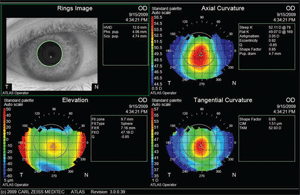 |
| 1. A decision maker can request a wide range of display information from a remote topography examination file without ever needing to touch the instrument. |
With these tools at hand, the eye care professional fulfills the ultimate responsibility of their licensure— decision-making and consultation, as opposed to information gathering. Instrument technologies, including imaging equipment, are designed to be easy to operate and are ideal for ancillary personnel with less training and experience than the licensed optometrist or ophthalmologist.
Introducing Cloud Technology
The next step in the evolution of electronic data management and access is the browser-based record system, in which the internet will be used to transfer the ever-larger database to remote servers. Such a system eliminates the need for and reliance on in-office servers. It also eliminates the need for the conduct of software upgrades in the offices of hundreds or thousands of system users.
Today’s high-resolution imaging and metrology, the speed and capacity of internet communication, and novel contact lens-enabled wearable displays support the potential for telehealth delivery for military and civilian market needs.
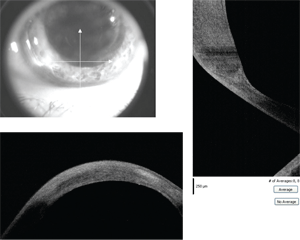 |
| 2. Instrument sharing, by way of a central technology clinic,
allows practitioners access to higher-cost imaging systems via examination information transfer. |
Such a system is ideal in information technology since the capacity can be increased and improved without each office having to invest in new infrastructure, license new software or train new personnel.5 In fact, Microsoft recently announced the refashioning of its Windows platform to facilitate cloud computing.6 It is expected that these systems will be dynamically scalable and will take the form of web-based tools or applications that users can access and use through a web browser as if the programs were installed locally on their own computers.7,8
Our Everyday Application
The cornea practice can be divided into diagnostic services, treatment protocol and case management, while the contact lens practice is parsed to include evaluation, virtual fitting, diagnostic lens evaluation and imaging, contact lens design and case management.
The notion of evidence-based health care includes the discovery of the finite elements of assessment or evaluation that support a diagnosis. These elements of evidence include symptom checklists, clinical signs, biochemical and histological assays, and visual observations—images which may be enhanced by high-resolution optical instruments that harness technology to modulate illumination sources or incorporate other methods to enhance image detection.
Telemedicine, at its core, is based on gathering pertinent information and images, and transferring them to a decision-maker for the purpose of making an accurate diagnosis and crafting an optimized treatment plan.
Today, anterior segment images can be gathered by use of digital cameras in biomicroscopes and optical coherence tomographers. Assays can be gathered using laboratory cultures, technology like TearLab for mearsuring osmolarity and the analysis of inflammatory mediators in the tear film.9 Centers remote from the decision-maker can be equipped and ancillary personnel can be trained to gather these data (figures 1 and 2).
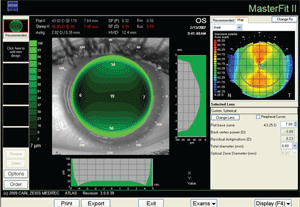 |
| 3. Topography-driven empirical prescribing systems integrate well into telehealth systems. |
Ultimately, diagnosis and treatment protocol can be developed as a firstlevel artificial intelligence to suggest conclusions from these collected images and data. The decisionmaker ultimately retains the fiduciary responsibility to accept or reject the diagnosis and treatment suggested by the artificial intelligence algorithm.
One such telemedicine service in optometry was developed by Lou Catania, O.D., of Atlantic Beach, Fla.10 Practitioners may access consultation services by providing pertinent data and receive support for a diagnosis, along with treatment recommendations.
The Department of Defense and the National Health Institute have demonstrated their interest in telemedicine for ophthalmic care through funding and grants to further develop the systems for use in the military. For example, the Telemedicine and Advanced Technology Research Center (TATRC) focuses on battlefield treatment and corneal wound healing through telemedicine.11
Technology in Today’s Practice
Contact lens fitting based on clinical measurements has more than a 50-year history with the empirical ordering of early polymethylmethacrylate (PMMA) corneal lenses based on keratometry and manifest refraction measurements. Two decades ago, computer-assisted video keratography emerged and with it came software for simulated fluorescein patterns and empirical contact lens designs based on the elevation data from the topographer (figure 3).
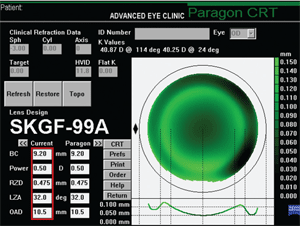 |
| 4. The Paragon CRT Topography software enables virtual fitting and visualization of changes of parameters. |
In the same manner, images of fluorescein patterns or OCT at the time of a follow-up visit may be provided to a consultant or decision-maker to suggest a change to the parameters of the final lens (figures 5 and 6).
Companies like WaveForm are developing systems using the wavefront measurements of an aberrometer to produce cutting files for custom lenses to correct higher-order aberrations like spherical aberration, coma and trefoil.14 These systems include image capture to assist in the registration of the lens orientation on the eye and the rotationally asymmetric higher-order aberration correction. Custom multifocal lenses are anticipated in the same manner using pupil size, pupil reactivity and the deviation of the geometric center of the lens from the visual axis (figure 7).15
The transfer of these data— gathered by the aberrometer and corneal topographer with diagnostic lenses in place—will be an emerging application of telemedicine for the contact lens practice. It is also anticipated that the modality of refractive error regulation for myopia, hyperopia and astigmatism may be refined and enhanced by transferring data from instruments that conduct peripheral refractions. In such a way, contact lenses will be designed to provide the proper optics for the peripheral retina or designed to properly reshape the cornea to provide the optics for the peripheral retina.
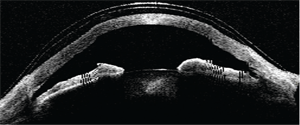 |
| 5. Anterior segment optical coherence tomography ushers in an
advancement in technology driven contact lens design selection to reduce chair time in scleral lens fitting. |
Surgical Visualization
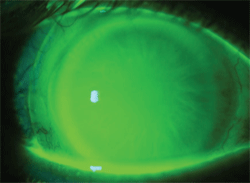 |
| 6. High-resolution digital single frame and video images can be transferred to consultants to enhance first-time order success rate. |
The iOptik contact lens-enabled wearable display (Innovega) is currently in development: The technology will provide a field of view up to the physiological limit of human vision.16 In such a manner, the equivalent of eight or more 15-inch monitors can be simultaneously placed in the superior portion of the spectacle lens, while the practitioner is free to view the site of their surgical procedure in a normal lower gaze. The head or torso would not have to move, and there would be no loss of attention from the active procedure.
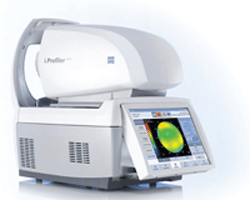 |
| 7. The combination corneal topographer, autorefractor and aberrometer gathers
valuable data for the cornea and contact lens practice. |
While systems like iOptik are in development and cloud computing continues to evolve, eye care practitioners can now use data transfer both within and outside their offices.17-19 Large health care delivery systems will expand their use of telemedicine to delegate information gathering, to lower personnel cost and to increase geographic access to patients.
Dr. Legerton is an author, lecturer, inventor and consultant to the ophthalmic industry. He was the managing partner of a seven doctor practice in San Diego for 26 years. He is a cofounder of SynergEyes and Innovega, and has 25 issued U.S. patents for contact lens technology including SynergEyes, Paragon CRT, myopia progression control, presbyopic laser refractive surgery and novel multifocal contact lenses. He has more than 40 pending applications, including those for the Innovega iOptik contact lens enabled wearable display technology.
1. Shimmura S, Shinozaki N, Fukagawa K, et al. Real-time telemedicine in the clinical assessment of the ocular surface. Am J Ophthalmol. 1998 Mar;125(3):388-90.
2. Yogesan K, Barry CJ, Eikelboom RH, et al. Advances in medical signal and information processing, 2000. First International Conference on (IEE Conf. Publ. No. 476). 2000 Sep:123-8.
3. Gartner. Gartner says cloud computing will be as influential as e-business. 2008 Jun. Available at: www.gartner.com/it/page.jsp?id=707508 (accessed September 2011).
4. Knorr E, Gruman G. What cloud computing really means. InfoWorld. Available at: www.infoworld.com/d/cloud-computing/what-cloud-computing-really-means-031 (accessed September 2011).
5. Cloud computing: clash of the clouds. The Economist. 2009 Oct 15. Available at: www.economist.com/node/14637206?story_id=14637206 (accessed September 2011).
6. Jones S. Ballmer ‘re-imagining’ Microsoft around new forms of computing. 2011 Sep 15. Total Telecom. Available at: www.totaltele.com/view.aspx?ID=467699 (accessed September 2011).
7. Buyya R, Chee SY, Srikumar V. Marketoriented cloud computing: vision, hype and reality for delivering IT services as computing utilities. Available at: www.gridBus.org/~raj/papers/hpcc2008_keynote_cloudcomputing.pdf (accessed September 2011).
8. Lillington K. Getting clear about cloud computing. The Irish Times. 2008. Available at: www.irishtimes.com/business-services/cloud-computing-ireland/getting-clear-about-cloud-computing
(accessed September 2011).
9. Kallinikos P, Morgan P, Efron N. Assessment of stromal keratocytes and tear film inflammatory mediators during extended wear of contact lenses. Cornea, 2006; 25(1):1-10.
10. Catania L. Cloud computing defined. Telemedicine Consults. 2010 July. Available at: www.loucatania.com/telemedicine.php (accessed September 2011).
11. Telemedicine & Advanced Technology Research Center. 2009 Annual Report. Available at: www.tatrc.org/docs/TATRC_report_2009.pdf (accessed September 2011).
12. Caroline P. What makes CRT different? CL Spectrum. 2002 Sep. Available at: www.clspectrum.com/article.aspx?article=12252 (accessed September 2011).
13. WAVE Contact Lens System. Wave screen detail. Available at: www.wavecontactlenses.com/wave-screen.html (accessed September 2011).
14. Waveform. Innovation for all to see. Available at: www.waveformlenses.com/html/technology.html (accessed September 2011).
15. Legerton, J, Liguori Management (2009) Mutifocal Contact Lens, U.S. Pat. 7,891,810.
16. Innovega. Available at: www.innovega-inc.com (accessed September 2011).
17. Smith LFF, Bainbridge J, Burns J, et al. Evaluation of telemedicine for slit lamp examination of the eye following cataract surgery. Br J Ophthalmol. 2003 Apr;87(4): 502-3.
18. Making telemedicine work. Rev Optom. 2008 Sep;145(9):12.
19. Byrne J. Telemedicine predicted to play a larger role in optometry. Primary Care Optometry News. 2006 Jun. Available at: www.pconsupersite.com/view.aspx?rid=69709 (accessed
September 2011).


